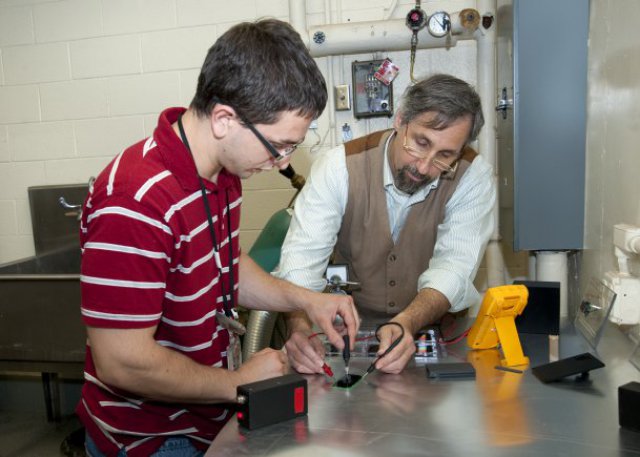 “Long-Lived Power” sounds like it could be an energy revolution, a revolutionary of sorts within the family of far-reaching energy solutions for the battlefield — because it uses radioisotopes.
“Long-Lived Power” sounds like it could be an energy revolution, a revolutionary of sorts within the family of far-reaching energy solutions for the battlefield — because it uses radioisotopes.
It is a power source that supports low power for years — 100 microwatts of average power — according to its developers.
Scientists at the U.S. Army Research Laboratory are testing tritium, a radioisotope that is produced in nuclear reactors, to power sensors. This alternative energy source could give sensors — the eyes and ears of warfighters — a battlefield energy source capable of lasting a 13-year half-life. Half-life is the measure of time it takes for the material to fall to half of its value.
“Other available isotopes last 100 years,” said Marc Litz, Ph.D., of the Power and Energy Division, who conceptualized the idea.
The laboratory is addressing the Army’s issue of weight and duration of usefulness among the limitations of chemical batteries.
“Chemical batteries are vastly available, but the small capacity means leaving a trail of batteries on the battlefield. In contrast, isotope batteries are a ‘deep well,’ but the ‘pipe’ is kept small — or in other words, the batteries give off a trickle charge but for many years,” Litz said.
“A trickle charge is useful when an Army squad needs awareness of activities happening in an isolated area,” Litz continued. “One way to keep them from the potential danger is sensing the acoustic and electromagnetic vibrations using a monitor that communicates the data back to a safer location. The isotope power source allows the sensors to operate with a power switch from kilometers away for extended periods of time. Isotopes store more energy in this way, or greater energy density, than chemical materials.”
“The team of researchers have designed and fabricated power source prototypes that house the tritium and other ingredients to charge the multi-functioning sensors in a battery format that Soldiers are comfortable using in the field,” Litz said. “One of the challenges of the research is to make sensors work at a low enough power level to make long-lived power a safe, practical and easy to handle resource.”
“Decaying isotopes are a concern,” said Dimos Katsis, who designs the energy-harvesting circuits with Athena Energy as part of Litz’s team. “The isotopes emit radiation in an amount comparable to that in local medical x-rays
“Radioactive elements like kryptonite, a fictional material that appeared to weaken the ‘Man of Steel,’ have given isotopes a bad name,” Katsis said. “But the trace levels of tritium that you would find in a theater exit sign or glow stick are just enough to power Army sensors that can detect acoustics and electromagnetic signals for more than 10 years.”
In order to use small amounts of tritium, which would be safe for any Soldier, reduced power output is necessary.
“It puts bounds on how much power we are willing to get out of the device,” Katsis explained. “This power source would never be used for something like a high-powered laser system.”
Another challenge the team has faced was housing the tritium in material that makes it safe and easily transportable.
“People are surprised to find the materials in the power source are less toxic than something like ibuprofen,” Katsis said.
“The team has been working on sensors for about three years, and it is still likely a couple years before long-lived power is useful to industry,” Litz stated. “We want to make the long-lived power devices smaller and even more efficient. Solutions like long-lived power are examples of ‘high-risk, high-reward’ basic science that is one of the laboratory focus areas.”
Photo: John Russo, who uses 3D printing to fabricate the Long-Lived Power battery casings, works with Marc Litz, Ph.D., both of the Power and Energy Division at U.S. Army Research Laboratory, to measure output voltage on space-grade photovoltaic cells before bonding tritium capsule to a photovoltaic wafer.
Source: US Army
